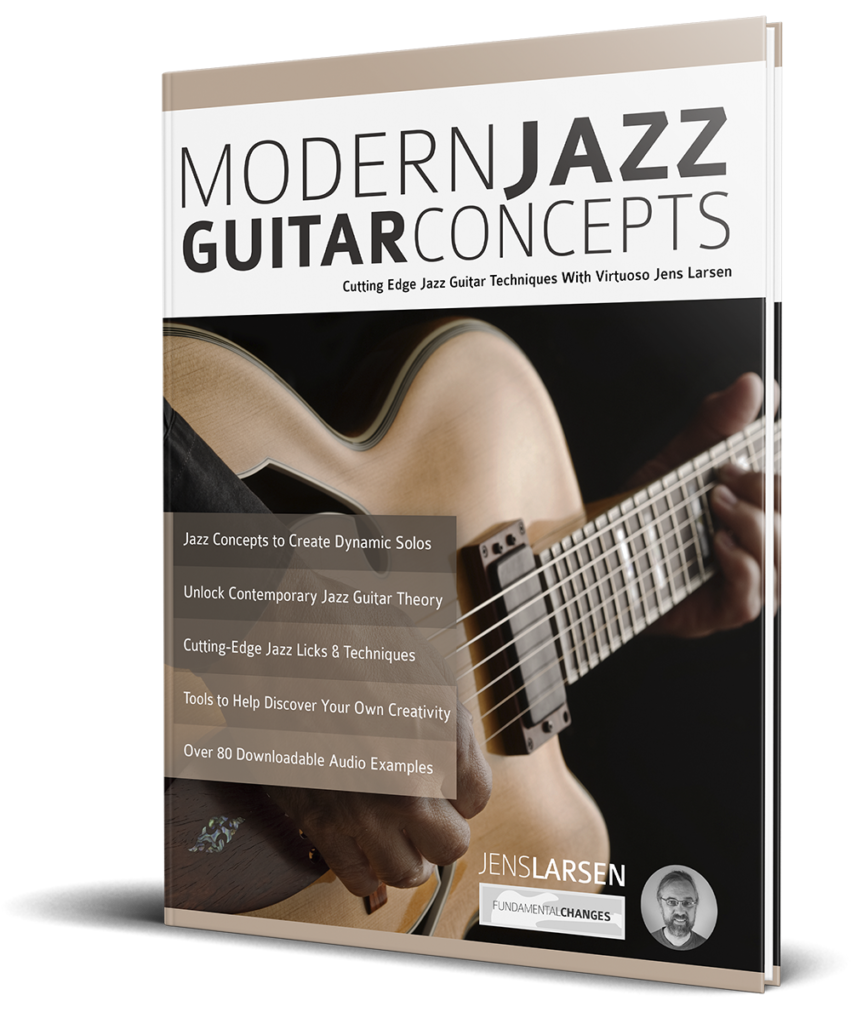
If you’ve been learning jazz guitar online, it’s nearly impossible to miss Jens Larsen’s presence on the internet. With his amazing library of instructional videos on YouTube as well as his frequent postings on Twitter, Instagram and Facebook, many might wonder how does Jens find the time to create so much material consistently!
In his first book with Fundamental Changes, Jens finally brings his teaching onto the print format (as well as eBook of course) addressing the topic of Modern Jazz Guitar. The book provides a step by step guide to getting into the style. Included are licks in the style of Kurt Rosenwinkel, Adam Rogers, Jonathan Kriesberg, Gilad Hekselman and Lage Lund – some of the leading guitarists in modern jazz guitar.
Within this 68-page book, Jens has organised 6 chapters that guides the aspiring jazz guitarist through the labyrinth of jazz music theory and fretboard knowledge.
In chapter 1, we are introduced to the major scales, playing diatonic triads including permutations, diatonic 7th chord arpeggios, upper structure and even some quartal lines. It’s an interesting way to begin and Jens manages to write a lot of detail behind how these single note lines are constructed.
In chapter 2, approach notes are introduced to add spice to our melodic lines. Jens discusses Barry Harris and Pat Metheny approaches to these chromatic enclosures. The chapter ends with practice suggestions that are helpful for those looking to explore this topic further.
In chapter 3, Jens shows how to use the harmonic minor scale on the V chord. There are a number of nice lines with interesting leaps melodically. Jens suggests the arpeggios he likes which helps filter the choices we encounter with this scale.
In chapter 4, Jens explores the altered scale on dominant chords. To create jazzier sounds, he selects some arpeggios that are useful to outline the tensions on the dominant chord. He shows how to use and resolves these more dissonant lines in a II-V-I setting.
Chapter 5 goes deeper into colour and tension with the application of the diminished scale on the dominant 7th chord. Jens suggests different triad pairs that are effective for creating lines and give good ideas for practicing this scale.
In the final chapter, all the concepts are combined in a 3 chorus blues solo. Each idea is also analysed to help us understand the construction. This is great especially when we want to create our own ideas using the same concepts.
In conclusion, this is a good book for anyone who is interested in getting started to play modern jazz guitar. In combination with good listening habits (checking out the players that Jens mentions throughout the book), the concepts are both explained and demonstrated to help guitarists new to the style. For those interested in just playing the lines, you can easily get the licks under your fingers with the clearly notated phrases. For those who want to get deeper into the concepts, you can read and study the explanations for each example. All in all, if you’ve been checking out his lessons on YouTube, this book is a good systematic collection of some of the key modern jazz guitar concepts behind the licks you’ve been listening.
Pros: Very well organised material with detailed explanations!
Cons: None.
TLDR: If you’re a fan of Jens Larsen, this book will provide a great summary of his approach to modern jazz guitar. A good book for beginner and intermediate guitarists looking for modern jazz guitar material to practice.
I received a review copy of this book from Fundamental Changes. Thank you Joseph and Amanda!
Get your copy here:
https://www.fundamental-changes.com/book/modern-jazz-guitar-concepts/
[Review Archive]
I wrote a lot of other book, course and video reviews too.
Check out the rest here:
[Read more reviews]
[Submissions for Review Consideration]
- Are you an author who wrote a jazz, guitar or music book?
- Have you created a DVD or an online video course or subscription based website?
- Would you like me to review your book/course?
Please send me a message at azsamad2 at gmail.com with:
For courses: a link to the course/video/product + access info etc.
For books: a link to the book (Dropbox) or PDF attachment (if it’s small) for review consideration.
Depending on whether I dig the book/course, I’ll let you know if I do plan to review it!
I cannot guarantee a review for every submission & if I’m not too into it, I may opt not to review it. I mean, it’s better to get a good review that for me to write a bad review just because it’s not a match for the kind of stuff I dig right? :p
NOTE: All reviews reflect my honest personal opinion so be aware that I will point out both cool Pros and Cons that I see in the work. You dig? 🙂
Is there an errata sheet for this book? I see, for instance, on page 13 the text talks about Example 1d which seems to actually be referring to the measures in Example 1f.
I bought the book in Kindle format. I have found at least the first chapter to be full of mis references like that.